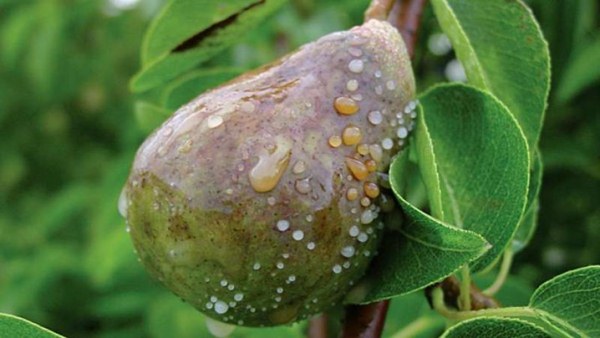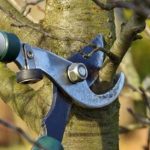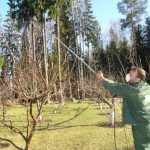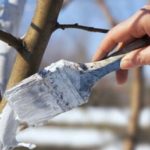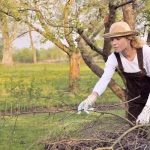Pear can be attributed to fruit crops that are found on almost every garden plot. But the positive emotions associated with the cultivation of this crop and the collection of tasty fruits can darken numerous diseases. They can not only degrade the decorativeness of the plant, but also lead to a significant reduction in yield and even death of the tree. In this article we will look at why pear diseases and treatment of various diseases occur.
Table of contents
- Common
- Tree proliferation, disease control methods
- Scab - fruits and leaves turn black, how to treat?
- Fruit Rot or Moniliasis
- Black fungus - black bloom on fruits and leaves
- Mealy dew - the leaves began to curl and dry
- Rust - why did yellow spots appear and what to do?
- Black cancer: signs and treatment methods
- Cytosporosis - burst bark and dry branches
- Bacterial Burn - Pear Leaves Turn Brown
- Bacteriosis: Pest Control
- Furrowing - wood disease
- Septoria, or white spot on the leaves
- Pear Disease Prevention
Common
Diseases of pears are numerous and can affect different parts of the plant. Many of them can affect not only pears, but other pome crops, such as apple, quince, loquat, hawthorn. What to do in case of disease of trees and how to treat them? With regular inspection of trees it is easy to notice signs of the disease, even in the early stages. Therefore, even a novice gardener needs to know the main diseases of pears.
The most common symptoms are:
- Changing the shape of leaves and fruits;
- The appearance of spots of different color and shape;
- The defeat of the young shoots and bark of old branches;
- Lignification of fruits and change in taste;
- Falling leaves, ovaries and fruits;
- Drying of the branches and the tree.
Tree proliferation, disease control methods
Pear proliferation is a viral disease, also called sprouting. Prematurely developed shoots depart from the plant at an acute angle. Numerous thin lateral shoots appear on the plants, dormant buds wake up, and the strong branching of the lateral fat shoots leads to the formation of witch brooms.
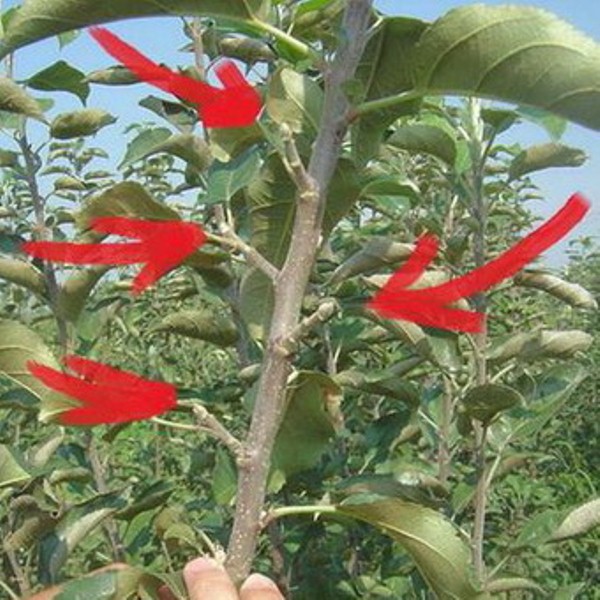
The leaves of diseased shoots, as a rule, have large well-developed stipules with a jagged edge. Flowers on infected plants do not fall off, and at the end of summer re-flowering may occur. Fruits are deformed, and the stem much elongated.
It is impossible to cure the disease, so when it comes to industrial plantations, it is better to create a new one with pre-tested healthy planting material.. In individual gardening, you can observe the state of the tree. Often the disease can turn into a latent form and practically does not appear, and the plant will develop and bear fruit normally.
Scab - fruits and leaves turn black, how to treat?
Pear scab is one of the most common diseases. In case of severe damage, not only the quality and quantity of fruits decreases, but also the trees dry out and freeze out.. The rapid development of the disease occurs if frequent precipitation and high temperatures contribute to the constant wetting of the plant.
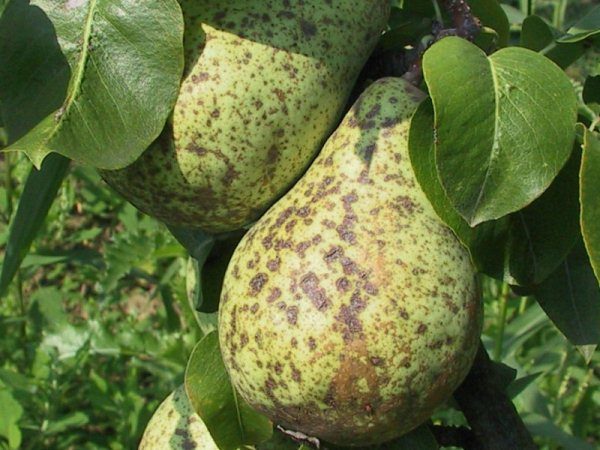
Scab - a disease of fungal nature. The first sign is the occurrence of rounded yellowish spots on all aboveground organs of the plant: branches, fruits, pedicels, leaves and petioles. Gradually, the spots necrotic, acquire a black color with a dark olive bloom. On the petioles and shoots in the places of defeat tubercles are formed, which later transform into ulcers, cracks and dents. Fruits form dark spots with a light rim. The flesh beneath them lumps, cracks appear, the fruits deform, and their quality and quantity are noticeably reduced.
The fight against the disease must be comprehensive. In the autumn, the affected leaves must be raked and burned, and the soil should be dug up under the trees. Thickened crowns should be thinned, removing dry and damaged branches.Damaged young shoots must be removed immediately. During leaf fall, it is recommended to treat with ammonium sulphate (10‑20%), silicate (0.1%) or urea (8%).
In the spring, it is necessary to spray the fungicides with a protective action for three times.: Bordeaux mixture (1%), copper oxychloride. The first time the trees should be sprayed before blooming buds, the second - after flowering, and after another 2 weeks to carry out the treatment of the third time.
Fruit Rot or Moniliasis
It affects a pear and an apple tree, less often other seed seeds. Sometimes found on stone cultures.
Symptoms of the disease can be detected not earlier than the middle of the vegetation periodwhen the fruits begin to pour. Small brown spots appear on the surface of the fetus, which quickly increase in size and can cover the entire fetus within a week. On the surface appear yellow-white or ash-gray pads, arranged in concentric circles. The flesh becomes loose and tasteless.
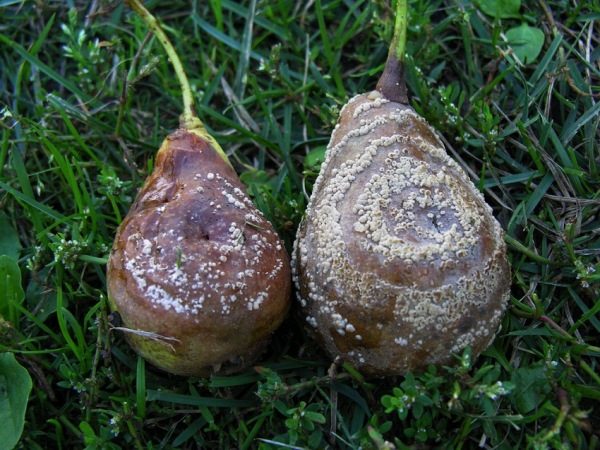
Fruit rot may also affect the skeletal branches. At the same time, dark indented spots appear, which sometimes can enclose a branch in the form of a ring, leading to drying of the upper part.
Often the fruits are stored on plants and serve as a source of infection for the next year. Crop may suffer from this disease even during storage. In this case, the fruits become black with brown flesh.
Particular attention should be paid to the destruction of insect pests, since it is damaged fruits that are affected by rot in the first place.
To combat fruit rot the same measures are effective as for dealing with scab. In the spring and autumn it is recommended to spray the Bordeaux mixture, and during the growing season to use fungicides (Fitosporin, Topsin, Folicourt). However, it is necessary to carry out the treatment at least one month before harvesting, or in the lines indicated in the instructions for the preparation.
Black fungus - black bloom on fruits and leaves
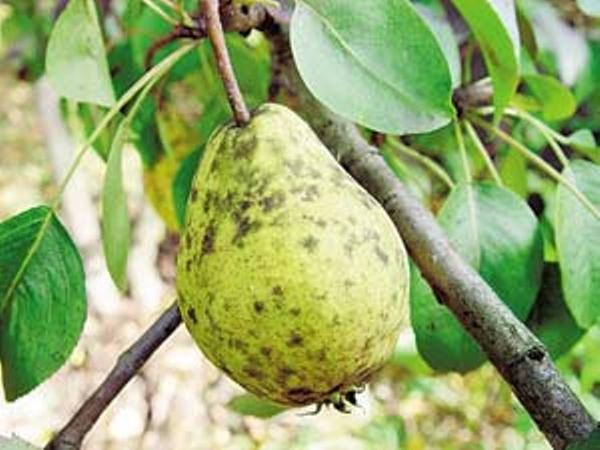
Black fungus most often appears after the petals fall off or during fruit filling. Dark spots appear on the branches, fruits and leaves, bloom that does not have clearly defined edges.. The appearance and taste of the fruit are reduced. The defeat of the shoots and leaves leads to stunted growth, reduced frost resistance and bookmark fruit buds.
The main reasons for the defeat of pears with soot are:
- Crown thickening;
- Poor air circulation in the garden or low location;
- Poor crown illumination;
- Damage by insects, because it is on their secretions (honeydew) that spores begin to develop.
To combat the fungus, it is necessary to reduce the population of sucking pests. (aphids, medianits). To protect the plants can be sprayed with copper fungicides. But most often, a special treatment against a black fungus is not required if treatments have been carried out from other fungal diseases.
Mealy dew - the leaves began to curl and dry
Peary mealy dew is considered one of the most dangerous diseases. The fungus infects the leaves, which can curl, shoots and fruits, leading to stunted growth and development, deformation and gradual shedding. Affected flowers become covered with a powdery touch and fall off, the ovaries do not form. As a result, up to 80% of the crop may fall off before the fruit is formed.
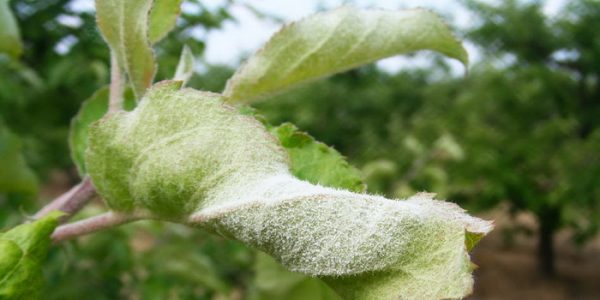
Favorable conditions for the spread of the fungus are considered high humidity at moderately high temperatures, but spore germination and infection can occur in almost any conditions.
The mushroom overwinters well on damaged shoots and does not freeze out even in the most severe winters, therefore in spring and autumn it is necessary to cut the damaged branches and burn, and to treat the trees with colloidal sulfur. To limit the development of the disease during the growing season it is necessary to spray systemic fungicides..
Rust - why did yellow spots appear and what to do?
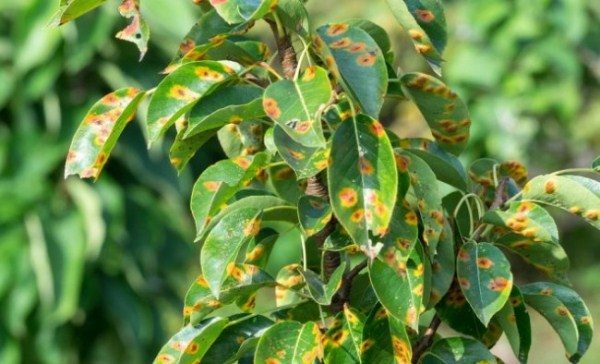
Signs of rust tend to appear on all green frequent plants immediately after flowering. A characteristic sign of the disease are round, large yellow spots, sometimes with a purple rim, on the lower side of the leaf blade yellow-green. Over time, black dots appear on the surface, spots bloat and burst.In affected plants, immunity and winter hardiness are reduced.
Most often, the disease appears in the autumn, in wet weather, in regions where the host plant is found in the wild-growing form or in household plots. At the first signs of rust, it is recommended to treat with a systemic fungicide.
In the spring, trees must be sprayed twice with Bordeaux mixture (1%): during budding and after flowering. In the fall, affected leaves and fruits should be destroyed, and shoots with signs of damage should be removed. Trees are recommended to be treated with urea solution (7%) after the leaves fall. You can also use fungicides: Bayleton, Skor, Topsin M, Fundazol, Delan, Tarcel.
In regions with a high probability of rust, it is better to grow varieties that are relatively resistant to the disease: Skorospelka, Duchess summer, Ilinka, Summer Williams and etc.
Black cancer: signs and treatment methods
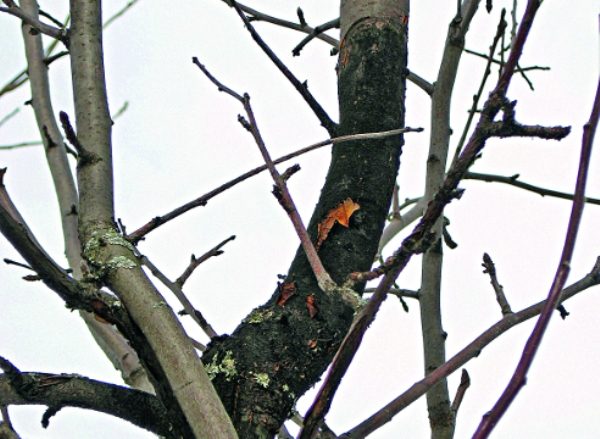
The disease affects the bark of skeletal branches and trunk. Numerous small depressed necrotic patches appear on the cortex near the lenticles.. On thin branches, lentils begin to grow, on thick - abundant gamma-therapy appears. The resulting wounds gradually increase in size, and the bark around it becomes brown. Reddish spots may appear on the leaves and fruits. Several types of fungi can cause these symptoms, and not only pome crops, but also stone fruits are affected by the disease. With a strong infection, the tree dies.
To do this, it is better to remove diseased plants, and at the initial stage of infection, prune all damaged branches to healthy wood. The wounds on the shtambe must be cleaned to healthy wood, treated with a solution of copper sulphate and covered with clay with the addition of mullein.
Cytosporosis - burst bark and dry branches
Cytosporosis is considered a disease of old weakened gardens, which are in poor physiological condition and constantly freeze slightly. On the annual shoots appear numerous black bumps and branches die. On the thick branches appear ulcers, which constantly grow, until they completely cover the entire branch. The bark becomes red-brown and dries. Gumming may occur.
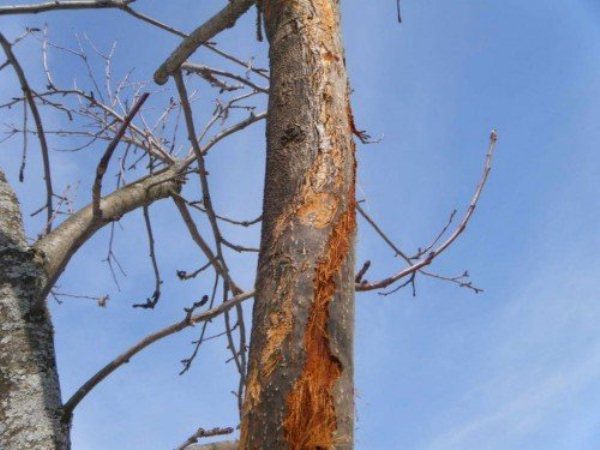
Chemicals to combat the disease does not apply. To avoid cytosporosis, it is necessary to remove the affected branches and trees, which are the main source of infection. When creating gardens, it is necessary to give preference to zoned varieties that will not freeze, and also to maintain a high agricultural background.
Bacterial Burn - Pear Leaves Turn Brown
Bacterial burn is considered one of the most dangerous diseases that affects more than 100 plant species. In infected plants, the flowers turn brown and fall off, the tips of the branches turn black, and the leaves and shoots are covered with watery black spots.. The tree quickly takes on the appearance of a scorched fire.
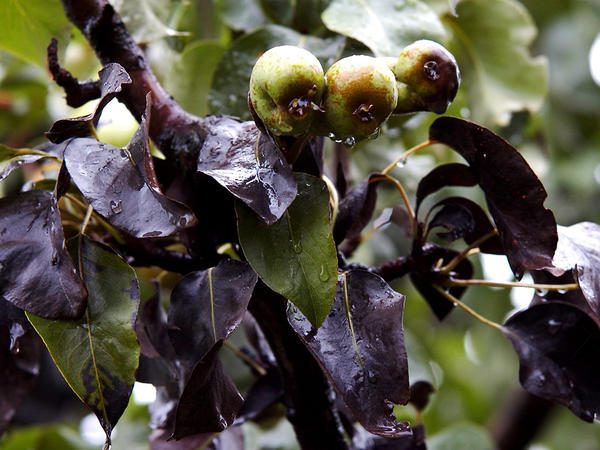
The bacteria that cause the disease can spread very quickly through wood loans to cause tissue death. The rapid course of the disease cannot be defeated.It is possible to only prevent the infection of other plants, therefore, the diseased tree must be removed and burned, and the roots uprooted. How to deal with this disease?
If it was possible to notice the disease at an early stage, it is necessary to cut the affected branches, and place the cut and tools with a solution of iron (0.7%) or copper (1%) vitriol. Spraying plants with antibiotics will be effective:
- Streptomycin (50 µg / ml);
- Chloramphenicol (50 µg / ml);
- Rifampicin (50 µg / ml);
- Gentamicin (50 µg / ml);
- Kanamycin (20 µg / ml).
Can also be treated with plants Bordeaux mixture and 7–8 times a season to spray copper-containing preparations.
Bacteriosis: Pest Control
The first signs of the disease appear with the blooming of young leaves.. At the ends of the laminae, dark areas appear, gradually spreading over the entire lamina and petiole, which subsequently begin to dry and may turn black.The disease affects the vascular system, which is easily seen on the cross-section of a branch in the form of black dots or circles.
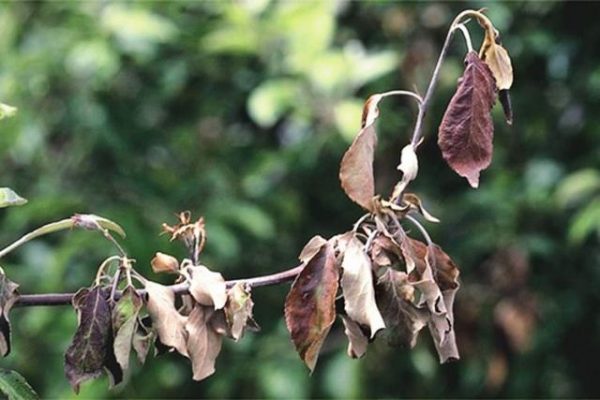
The degree of damage may be different, but trees of all ages are prone to disease. To combat bacteriosis, pruning is necessary., grabbing 30-40 cm of healthy wood, Slices handle copper sulphate (3%), as well as spraying Bordeaux mixture.
Furrowing - wood disease
The causative agent of the disease is a virus that is transmitted from tree to tree by mechanical means, when pruning or grafting. Branches of affected plants flatten, and dead patches appear inside. Well visible grooves, necrotic lines and spots. The leaves are chlorotic, early acquire autumn color and fall.
Septoria, or white spot on the leaves
Disease of abandoned and aging gardens. On the leaves appear small spots of light brown color, gradually graying, but with a dark rim.Such leaves dry out and fall off earlier than usual, and the viability and productivity of trees is reduced. Plants weakened by septoria are poorly resistant to low temperatures and often freeze slightly..
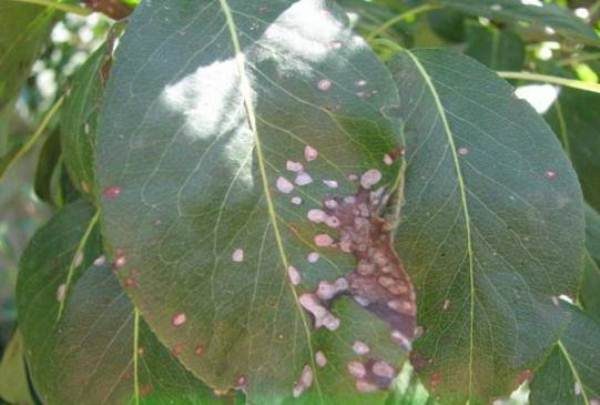
Special treatments for septoria, as a rule, do not hold, because the prevention measures used for scab effectively prevent white spot.
Pear Disease Prevention
It is not easy to avoid diseases, especially in suburban areas, where the pathogen may appear due to careless neighbors or abandoned wild gardens. However, most pear diseases can be prevented.
It is necessary to realize that prevention includes a complex of agrotechnical measures that are recommended to be carried out regularly. It is necessary to highlight the following preventive measures:
- Growing healthy planting material;
- Tool processing after pruning diseased trees;
- Cleaning leaves and windfalls;
- Deep soil loosening under the trees;
- Regular crown lightening, removal of weak, diseased and shriveled branches;
- Cleaning and whitewashing trunkstreatment of frost and injuries;
- Early spring and autumn spraying Bordeaux liquid, or other drugs according to the calendar of treatments;
- Fighting insect pests.
- Cropping for crown formation
- Spraying bordeaux liquid
- Whitewashing trunks
- Loosening the soil under a tree
- Sanitary pruning and cleaning
Growing pears and getting a decent harvest requires attention and certain knowledge. It is necessary not only to take care of the tree properly, but also to learn to see the first signs of a lesion, to distinguish diseases characteristic of a given culture, and to take the necessary measures in a timely manner.. And in order not to collide at all or to minimize the number of diseases it is always useful to pay attention to simple methods of prevention.
